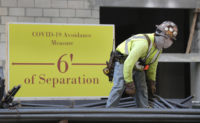Design Professional Insurance
Viewpoint: Adjusting to the ‘Post-Truth’ Environment Driving Up Insurance Claims Costs

Reptile legal theory has transformed claims. Photo: June via Getty Images
Social Inflation is a term insurers are using to describe increasing insurance losses. It is fueled by societal instability and appeals to emotion and fear, which cause higher jury awards, larger settlements and the inevitable result—more litigation.
COVID-19 now has the potential to accelerate social inflation, or actually reduce it—and that has complicated insurance claims in several ways.
Over the past decade, the plaintiffs' bar has exploited primitive human responses to fear as a way to inflate verdicts. COVID-19 has further broken down societal structure and created instability in nearly all aspects of our lives. As a consequence, design and construction professionals need new approaches to manage risk in this changing environment.

How did we get here? In 2016, Oxford Dictionaries’ "word of the year" was “post-truth.” According to Oxford, post-truth is “an adjective defined as "relating to or denoting circumstances in which objective facts are less influential in shaping public opinion than appeals to emotion and personal belief."
As we emerged from the financial crisis of 2008 and 2009, we began to see an anti-institutional shift that was, at first, based on the bailouts of banks “too big to fail.” Through the last decade, appeals to emotion and fear have proved both effective and overwhelming across advertising, politics and business.
As "post-truthism" was ramping up, something similar was happening in litigation, typified by the publication of Reptile: The 2009 Manual of the Plaintiff's Revolution. The premise of the “reptile theory” is that plaintiffs can prevail at trial by speaking to, and instilling fear within, the primitive parts of jurors’ brains that respond to fear and have been programmed through evolution for self-preservation.
Reptile theory seeks to replace individual judgment on the facts and circumstances at issue with an emotional response stemming from fear.
The pandemic has destabilized our society, upending familiar patterns of life and introducing new conflicts. Many risk managers anticipated that it would bring about a return to a more sober and calculated approach to risk, driven by science and reason.
"As we analyze the lessons learned from the pandemic, how do we manage the risks faced by architects and engineers in the post-COVID world?"
In fact, the opposite might be true. Methods that exploit fear and emotion as primary vehicles of persuasion are now even more common across society. According to a 2021 study by the jury consulting firm Magna Legal Services, more than 80% of prospective jurors believe their role is “guardian of the community,” rather than simple arbiters of the facts of a case. That figure is up more than 30% from before the pandemic.
The next decade of risk management will be predicated in large part on how the human condition responds to the fear and emotional instinct thrust upon it. As we analyze lessons learned from the pandemic, how do we manage the risks faced by architects and engineers in a post-COVID world?
'How Much Do You Want My Client to Give You?'
First, we must change our mindset by applying contemporary, creative and open-minded strategies to navigate this new reality.
Second, we should have our finger on the pulse. Our culture and politics are reflected in our juries, judges and litigants. Insurers, lawyers and clients must continually re-assess their risk appetite based on the specifics of each case. This is especially true of firms practicing across legal jurisdictions, as attitudes and dispute resolution change from place to place. The defense bar let "reptile theory" sneak up on it nearly a decade after its publication. Now it must adjust.
Third, our views of the “facts” may matter less than we would like. We may need to ask ourselves more emotionally-oriented questions: Why is the owner troubled? Why does the personal injury plaintiff want our money? When I was a litigator, two simple but key questions I would ask in a deposition are: “How much money do you want my client to give to you?” Then, “Why?” The responses are telling.
Fourth, we need to understand that, like facts, contracts don’t always matter. In some cases, equity, empathy and conscience may supplant the “deal” that was agreed to, even between sophisticated businesses. Consider a hypothetical in which an environmentally friendly business would likely fail if forced to pay what's required by a contractual clause that shifts the attorney’s fee to the other party. Will jurors follow their heads, or their hearts, in deciding whether to uphold the contract? We must be mindful of how a third party might look at a deal when drafting and negotiating contractual language.
Fifth, it seems like everyone is now an “expert” in every field. When everyone is an expert, nobody is an expert. Thus, we need to reassess our reliance on expert witness testimony. We must ask, does the expert appear trustworthy? Is the expert emotionally calibrated to fear the same things our juries fear?
Lastly, juries are increasingly unpredictable, which may make arbitration more appealing.
Above all else, understand that other people and parties might be coming into a problem from a highly emotional standpoint. Remember that today, risk management and dispute resolution programs are no longer served merely by good work and strong contracts.
So my advice is to choose your clients carefully and work closely with insurance brokers, claims specialists and attorneys when a claim arises. They understand how the litigation environment has changed and can help you mitigate your exposure.
Michael Germano manages claims for design and construction professional clients at specialist insurer Beazley, and oversees its specialty professions claims portfolio. Previously a construction litigator in Washington, D.C., he can be reached at michael.germano@beazley.com.




